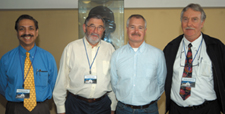|
|
Vol. 28 No. 1
January-February 2006
Advanced Materials—WAM III
by Piet Steyn and John Corish
The very successful IUPAC New Directions in Chemistry—
Workshop in
Advanced Materials (WAM III) attracted more than
150 participants to South Africa on 4–9 September 2005.
 |
| Left to right: Professor Ayusman Sen, Pennsylvania State University, plenary lecturer; Professor John Corish, Trinity College Dublin, chair of the international organizing committee; Professor John Boland, Trinity College Dublin, plenary lecturer; and Professor Ron Sanderson, University of Stellenbosch, chair of the local organizing committee. |
The workshop was funded under IUPAC’s program for conferences in emerging regions and was organized by the University of Stellenbosch’s United Nations Educational, Scientific and Cultural Organization (UNESCO) Associated Center for Macromolecules and Materials, with professor Ron Sanderson chairing the local organizing committee. The first two workshops were held in Singapore (in July 1999) and Bangalore (in February 2002), respectively. Overall responsibility for the workshops rests with the IUPAC Interdivisional Subcommittee on Materials Chemistry.
WAM III focused on nanostructured advanced materials and featured eight sessions addressing new synthetic routes for the production of nanostructured materials, nanoelectronics, nanotubes and fibers, design and self-assembly, biorelated materials, and device characterization and applications. The workshop was opened on behalf of IUPAC by past president Piet Steyn. C.N.R. Rao, another former president and the organizer of WAM II, also participated and presented a plenary lecture. The plenary and invited lectures will be published in a special issue of Pure and Applied Chemistry. The journal’s scientific editor, James Bull, also attended the conference.
WAM III concentrated on the vital role played by chemists in the design and fabrication of nanostructured materials, with a particular emphasis on soft chemistry. The presentations covered an exhaustive range of established and novel synthetic techniques for the preparation of nanoparticles as well as nanotubes and a variety of nanostructured films, nanocomposites, and nanoporous materials. All of the principal characterization techniques were also covered, with particularly impressive presentations given on the latest developments in the use of scanning tunneling microscopy and atomic force microscopy on silicon surfaces. The current and future technological utilization of nanomaterials as coating materials, electrocatalysts, and electronic components, as well as their application in chemical separations, fuel cells, and other novel energy technologies and in medicine were also discussed, as was the potential offered by autonomous nanoscale motion through catalysis.
|
| Sanjay Mathur (1st on the left) and Ron Sanderson (5th) with some of the participants of the bilateral German-South African minisymposium. Funding from the national research foundations of South Africa and Germany enabled the participation of 10 young South African and German scientists. |
The WAM III program also incorporated a bilateral German-South African minisymposium organized by Sanjay Mathur and Ron Sanderson and jointly funded by the National Research Foundation (South Africa) and the Deutsche Forschungsgemeinschaft (Germany). All of the presentations at the symposium were given by research students.
In addition, the South African Department of Science and Technology generously sponsored poster awards for young chemists. First prize was given to Ziboneni Godongwana of the South African Institute for Advanced Materials at the University of the Western Cape for the poster entitled “Inexpensive production of graphitic mesoporous carbon material.” Second prize was given to Rushanah Mohamed and Ziboneni Godongwana, from the same institute, for a poster entitled “Preparation and characterization of proton conducting membranes for direct methanol fuel cell applications.”
The success of WAM III in terms of its educational objective may best be judged by the fact that many more students than established scientists attended. Moreover, the rapidly growing interest in materials chemistry in general, and nanoscience in particular, is reflected in the fact that the workshop was significantly larger than its predecessors. Notably, it was attended by delegates and students from the African countries of Algeria, Ethiopia, Lesotho, Libya, Mozambique, Nigeria, Senegal, and South Africa.
Piet
Steyn <[email protected]>,
a professor at the University of Stellenbosch, was a member
of the local organizing committee and the IUPAC representative.
John Corish <[email protected]>
is the chairman of the IUPAC
Interdivisional Subcommittee on Materials Chemistry and
the WAM III International Organizing Committee.
Page
last modified 6 January 2006.
Copyright © 2003-2006 International Union of Pure and
Applied Chemistry.
Questions regarding the website, please contact [email protected]
|